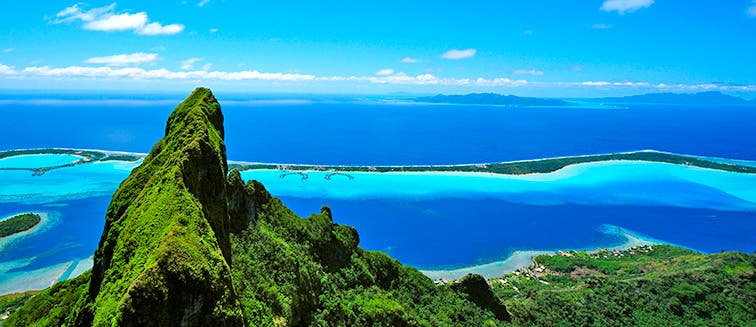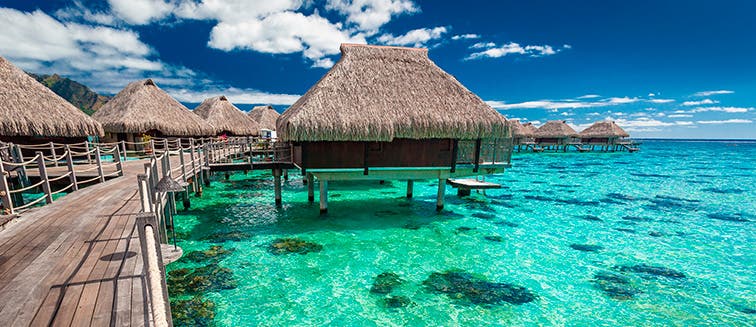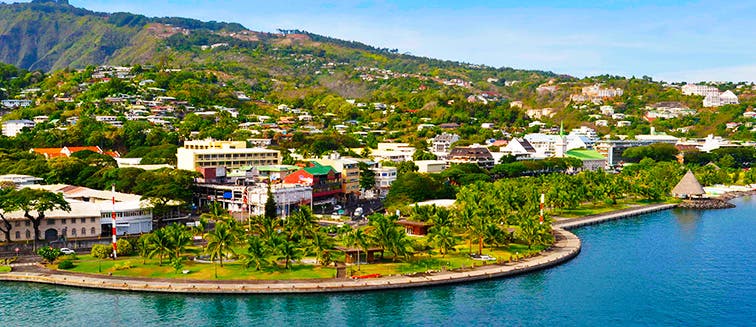A real-life tropical paradise, French Polynesia is a collection of more than 100 islands and atolls scattered across the South Pacific Ocean. Famous for its overwater villas, spectacular beaches and rich Polynesian culture, a holiday to French Polynesia is an indulgence of a lifetime. There aren’t enough adjectives in the English language to describe the natural beauty of these remote islands, but heavenly, breathing and inspiring are just a handful you could apply to this earthly paradise!
Of the 118 islands, just 67 are inhabited. Furthermore, French Polynesia can be geographically split into five island groups: the Society Islands, the Tuamotu Archipelago, the Gambier Islands, the Marquesas Islands and the Austral Islands. The most popular holiday destinations in French Polynesia can be found within the Society island group, including Tahiti, home to the capital of Papeete, as well as Moorea, Bora Bora and Huahine.
A honeymoon to French Polynesia is the stuff that newlywed dreams are made of, and French Polynesia is eternally popular for romantic beach escapes and couples getaways. Nevertheless, the country’s abundant natural landscapes, exquisite lagoons and volcanic peaks continue to draw lovers of the great outdoors, who long the explore the picture-perfect views and soul-stirring sunsets this archipelago is famed for.
For a trip of a lifetime to a distant paradise where nature reigns supreme, be sure to travel to French Polynesia!
History of French Polynesia
The human history of these volcanic islands can be traced all the way back to 1500 BC when the ‘Great Polynesian Migration’ brought Austronesian people to these remote islands in the South Pacific. It was not until the 16th-century that Europeans discovered this distant archipelago and began charting their location and geography. Trade soon followed, and in 1842, France established a protectorate in the islands. Decades of conflict followed, known as the Leewards War. It was not until 1946 that Polynesian’s were granted French citizenship and the islands received overseas territory status. Now autonomous, if you travel to French Polynesia you can explore a variety of historic sites to uncover both indigenous and French culture. Get to know ancient Tahitian beliefs systems at the village of Maeva on Huahine, home to over 40 stone temples, known as ‘maraes’, or witness traditional folklore and performances at Moorea’s Tiki Village. On the other hand, a trip to French Polynesia would be incomplete without exploring the rich artistic legacy of French painter, Gaugin, at his namesake museum or seeing the colourful colonial architecture of Papeete, such as the late 19th-century Notre Dame Cathedral.
Nature in French Polynesia
Scattered across more than 2,000 kilometres of ocean, French Polynesia is vast and diverse. A tropical and subtropical climate nurtures an incredible array of flora and fauna, most notably the sweet-smelling Tahitian tiaré, one of the world’s most fragrant blooms, found exclusively on the Society Islands. Many thousands of miles away from other continents, French Polynesia’s natural wonders are abundant and unique. In particular, French Polynesia is home to a number of endemic bird species such as the Tahitian monarch flycatcher, the green heron and the laughing kookaburra. Of course, below sea level, French Polynesia boasts incredible underwater biodiversity. Adorned with vast coral reefs, the waters surrounding French Polynesia are rich in marine life. Starfish, sea urchins, oysters, sharks, rays and sea turtles can all be found in the warm waters of the South Pacific, so a boat trip is a must-do if you travel to French Polynesia. Porpoise and dolphin sightings are frequent, and these marine animals hold a special symbolic significance in ancient Polynesian culture.
The highest peak in the country, Mount Orohena, can be found on the island of Tahiti and is a popular hiking destination. Other natural wonders to encounter on a French Polynesia tour include the beautiful, gravity-defying Vaipo Falls, the enchanting Bora Bora Lagoon and the vanilla plantations of Raiatea Island.
French Polynesia can be said to have two seasons: the hot and humid season and the cool and dry season. The hot, humid season runs between November and April, with the rainiest months being December and January. The cool, dry season is just a little cooler, with average temperatures hovering between 20 and 25 degrees Celsius between May and October. Nevertheless, a pleasant, tropical climate can be enjoyed throughout the year, therefore there’s never a bad time to visit French Polynesia!
Culture in French Polynesia
French Polynesian culture is filled with rich, expressive traditions. Music, dance and art are deeply ingrained in national culture, and if you travel to French Polynesia you'll soon notice this fact, be it an impromptu ukelele performance or the elaborate tattoos sported by many Polynesian locals. In fact, the word ‘tatau’ originated from the island of Tahiti! Here, tattoos hold a very sacred and symbolic meaning and were traditionally used as a means of spiritual protection, to show status or to connect with ancestors. Each motif has a particular meaning and learning more about this tradition of body art is an incredible way to gain an understanding of Polynesian culture.
Flowers are another essential part of French Polynesian culture, and when you arrive on the islands you’ll likely be greeted with a traditional flower necklace or lei. Furthermore, Tahitians often decorate their hair with the colourful, fragrant and exotic flowers that grow on these naturally abundant islands.
French and Tahitian are the main languages spoken throughout French Polynesia, although each island group has its own languages. Nevertheless, if you travel to French Polynesia you’ll find that many locals speak English, as tourism is an important part of the local economy.


